If you like adventure, sooner or later you are going to help an injured partner. If you are a big-time adventurer, the injuries are going to be complicated. To help you think of solutions when in a pickle, consider reading Climbing Self-RescueMuch of the book is technical, but everybody can find an idea.
Should be on the shelves of any serious, regular climber.
Gem of a bookIts backpack-suitable size and laminated cover make it appropriate for field or armchair use.
A must-readThe easy-to-read book illustrates step-by-step procedures for everything from passing knots through belay devices to rope-soloing safely to rescuing an injured leader. Those with a working knowledge of rope management and anchor systems can understand the techniques.

THE MOUNTAINEERS BOOKS
is the nonprofit publishing arm of The Mountaineers Club,
an organization founded in 1906 and dedicated to the exploration, preservation, and enjoyment of outdoor and wilderness areas.
1001 SW Klickitat Way, Suite 201, Seattle, WA 98134
2006 by Andy Tyson and Molly Loomis
All rights reserved
First edition: first printing 2006, second printing 2008, third printing 2009
No part of this book may be reproduced in any form, or by any electronic, mechanical, or other means, without permission in writing from the publisher.
Manufactured in the United States of America
Acquiring Editor: Christine Hosler
Project Editor: Mary Metz
Copy Editor: Julie Van Pelt
Cover and Book Design: The Mountaineers Books
Layout: Peggy Egerdahl
Illustrator: Mike Clelland
Photographs by Molly Loomis and Andy Tyson unless otherwise noted.
Cover photographer: Mark Fisher
Frontispiece: The need for self-rescue skills can arise when least expected.
Library of Congress Cataloging-in-Publication Data
Loomis, Molly, 1977
Climbing self-rescue : improvising solutions for serious situations / by Molly Loomis and Andy Tyson.1st ed.
p. cm.
Includes index.
ISBN 0-89886-772-X
1. MountaineeringSearch and rescue operations. 2. Mountaineering accidents. I. Tyson, Andy, 1968-II. Title.
GV200.183.L665 2005
796.5'220289dc22
2005035066
CIP
 Printed on recycled paper
Printed on recycled paper
ISBN: 978-0-89886-772-5
Contents
Acknowledgments
An enormous thank-you for the information, experiences, and time generously shared by Mike Clelland!, Kelly Cordes, Kevin Emery, Mark Fisher, Will Gadd, Ben Gilmore, Tony Jewell, A.J. Linnell, Nick Lewis, Allen O'Bannon, Jen Pine, Andy Rich, Louis Saas, Toby Schmidt, Phil Schneider, Clyde Soles, Garth Willis, and folks at the following organizations: Werner Braun (Yosemite Search and Rescue); Colby Coombs (Alaska Mountaineering School); Lisa Gnade (DMM); Mike Gibbs (Rigging For Rescue); Gordy Kito and Maureen McLaughlin (Denali National Park); Tom Moyer (Salt Lake Country Search and Rescue); Ken Phillips (Grand Canyon National Park); Kolin Powick (Black Diamond Equipment Ltd.); Paul Roderick (Talkeetna Air Taxi); Jim Ewing and Paul Niland (Sterling Rope); Jed Williamson (AAC's Accidents in North American Mountaineering); Julie Van Pelt (JVP Editing); Christine Hosler and Mary Metz (The Mountaineers Books). (Organizations are listed for identification only.) And our parents!
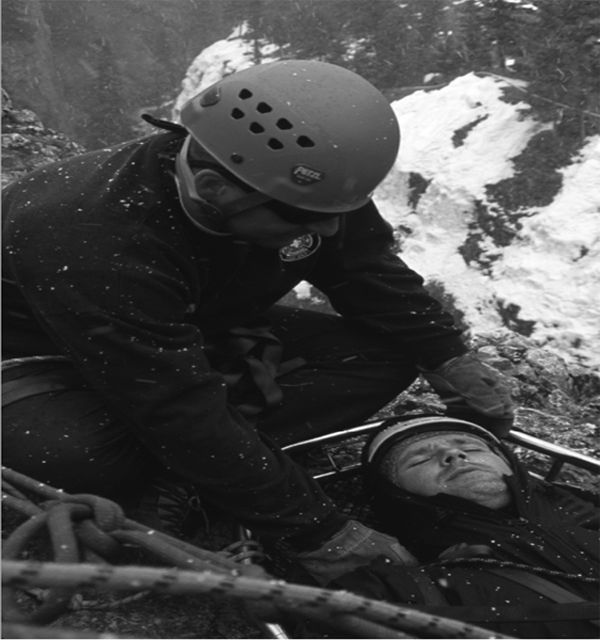
Good rescue skills can minimize or eliminate the need for outside help.
Introduction: Why Self-Rescue?
Climb long enough and at one point or another getting stuck in a jam high up off the ground is inevitable: stuck ropes, a crucial piece of gear missing in action, wandering off-route into dicey terrain, or an injury that leaves a climber in need of help. Typically, we piece or puzzle our way to a solution and move forward. Climbers are generally smart and resourceful, able to handle challenging situations, so why a whole book on self-rescue techniques?
Flip through the annual Accidents in North American Mountaineering (ANAM) and some obvious trends become evident. Most, if not all, climbers strive to climb in a safe, intelligent, and independent manner, but we often up the ante when we climb with less-experienced partners, fail to practice our rescue techniques (until the crucial moment), forget that we are smart and act dumb, or we end up just needing to learn the hard (sometimes very hard) way. There are plenty of accidents every year that ANAM does not cover; in fact most accidents included are documented because there was outside help provided for the party. Many accidents are never reported because the climbers were able to take care of themselves, using their problem-solving, first-aid, and rescue skills to handle the situation independently.
With a little more know-how and practice, many of the reported accidents could be handled better by the party in the mountains or on the rock. The more effectively you as a climber are able to control the situation (e.g., by getting your partner safely down the route to the base of the climb rather than waiting midroute for rescue by an outside party), the less effort (and risk) is required of outside rescuers. Depending on the situation, by employing self-rescue skills you may be able to eliminate the need for outside assistance entirely, if outside assistance is even an option. Depending on weather, local resources, and your location, it may not be. Organized rescue efforts are time-consuming, people-and gear-intensive, and are often costly, not to mention risky for rescuers (frequently volunteers). A solid grasp of self-rescue skills helps everyone in a bad situation. Remember that novice partners may find themselves needing to rescue you if things go awry. This book is not just for you; it is for your partner as well.
NUTS AND BOLTS
Climbing: Self Rescue seeks to inform readers how to confidently handle rescue scenarios ranging from simple to complex in all mediums of the vertical worldrock, snow, and iceand also aims to serve as a resource by sharing technical tips and tricks, resources for continuing education, and data regarding both climbing-related injuries and climbing gear. It is our hope that this type of information, which helps further your skill base, can help prevent you from getting into trouble in the first place.
This is not a text on prevention of accidents; on the contrary, it assumes that you may find yourself in a situation that requires good critical thinking and creative rope work to alleviate. Prevention is, however, an overall goal, and one way to learn about prevention is to realize the penalty of failure. Understanding the reality of the real-life situations presented in this book will make any smart climber focus on prevention.
As in life, in climbing there are often multiple ways to solve a single problem. Certainly some solutions are more efficient than others and each has benefits and downsides; but the bottom line is that the best solution is the one that you as a rescuer can execute successfully and safely. In writing this book we have tried to avoid a black-and-white approach to explaining rescue skills (i.e., using words like always and never). A dogmatic teaching style only hinders development of the critical thinking we believe is so important to being a competent, confident, and safe climber.

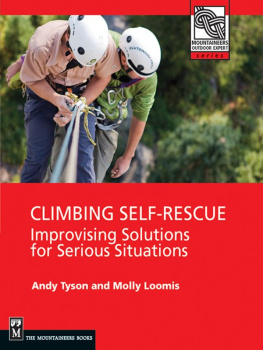

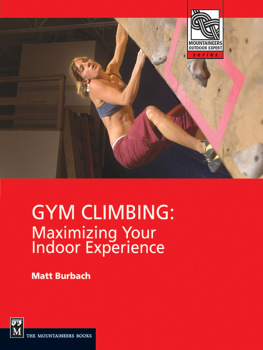
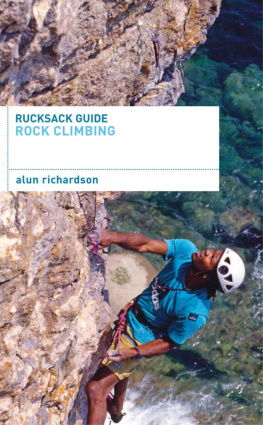
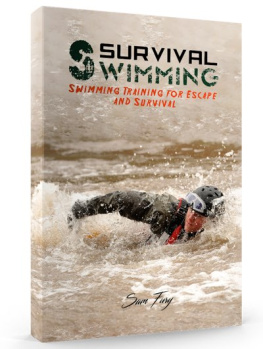

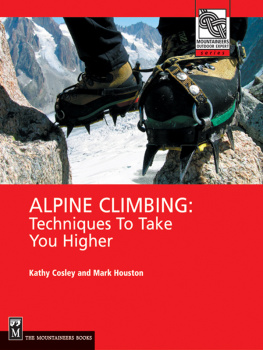
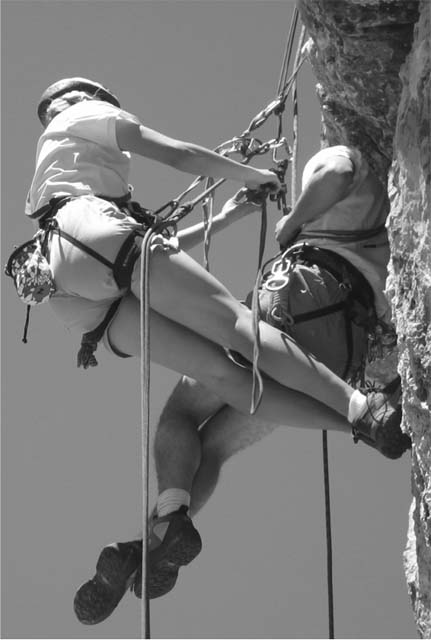


 Printed on recycled paper
Printed on recycled paper